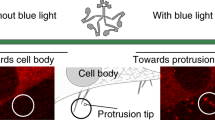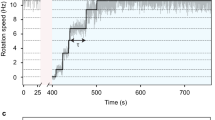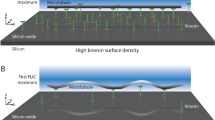Abstract
Cytoskeletal motors perform critical force generation and transport functions in eukaryotic cells1,2. Engineered modifications of motor function provide direct tests of protein structure–function relationships and potential tools for controlling cellular processes or for harnessing molecular transport in artificial systems3,4. Here, we report the design and characterization of a panel of cytoskeletal motors that reversibly change gears—speed up, slow down or switch directions—when exposed to blue light. Our genetically encoded structural designs incorporate a photoactive protein domain to enable light-dependent conformational changes in an engineered lever arm. Using in vitro motility assays, we demonstrate robust spatiotemporal control over motor function and characterize the kinetics of the optical gearshifting mechanism. We have used a modular approach to create optical gearshifting motors for both actin-based and microtubule-based transport.
This is a preview of subscription content, access via your institution
Access options
Subscribe to this journal
Receive 12 print issues and online access
$259.00 per year
only $21.58 per issue
Buy this article
- Purchase on Springer Link
- Instant access to full article PDF
Prices may be subject to local taxes which are calculated during checkout



Similar content being viewed by others
References
Sellers, J. R. Myosins: a diverse superfamily. Biochim. Biophys. Acta 1496, 3–22 (2000).
Vale, R. D. The molecular motor toolbox for intracellular transport. Cell 112, 467–480 (2003).
Goel, A. & Vogel, V. Harnessing biological motors to engineer systems for nanoscale transport and assembly. Nature Nanotech. 3, 465–475 (2008).
Goodman, B. S., Derr, N. D. & Reck-Peterson, S. L. Engineered, harnessed, and hijacked: synthetic uses for cytoskeletal systems. Trends Cell Biol. 22, 644–652 (2012).
Korten, T., Birnbaum, W., Kuckling, D. & Diez, S. Selective control of gliding microtubule populations. Nano Lett. 12, 348–353 (2012).
Cochran, J. C., Zhao, Y. C., Wilcox, D. E. & Kull, F. J. A metal switch for controlling the activity of molecular motor proteins. Nature Struct. Mol. Biol. 19, 122–127 (2012).
Chen, L., Nakamura, M., Schindler, T. D., Parker, D. & Bryant, Z. Engineering controllable bidirectional molecular motors based on myosin. Nature Nanotech. 7, 252–256 (2012).
Marriott, G. & Heidecker, M. Light-directed generation of the actin-activated ATPase activity of caged heavy meromyosin. Biochemistry 35, 3170–3174 (1996).
Goguen, B. N., Hoffman, B. D., Sellers, J. R., Schwartz, M. A. & Imperiali, B. Light-triggered myosin activation for probing dynamic cellular processes. Angew. Chem. Int. Ed. 50, 5667–5670 (2011).
Yamada, M. D., Nakajima, Y., Maeda, H. & Maruta, S. Photocontrol of kinesin ATPase activity using an azobenzene derivative. J. Biochem. 142, 691–698 (2007).
Derr, N. D. et al. Tug-of-war in motor protein ensembles revealed with a programmable DNA origami scaffold. Science 338, 662–665 (2012).
Kamei, T., Fukaminato, T. & Tamaoki, N. A photochromic ATP analogue driving a motor protein with reversible light-controlled motility: controlling velocity and binding manner of a kinesin-microtubule system in an in vitro motility assay. Chem. Commun. 48, 7625–7627 (2012).
Uyeda, T. Q., Abramson, P. D. & Spudich, J. A. The neck region of the myosin motor domain acts as a lever arm to generate movement. Proc. Natl Acad. Sci. USA 93, 4459–4464 (1996).
Tsiavaliaris, G., Fujita-Becker, S. & Manstein, D. J. Molecular engineering of a backwards-moving myosin motor. Nature 427, 558–561 (2004).
Liao, J-C., Elting, M. W., Delp, S. L., Spudich, J. A. & Bryant, Z. Engineered myosin VI motors reveal minimal structural determinants of directionality and processivity. J. Mol. Biol. 392, 862–867 (2009).
Schindler, T. D., Chen, L., Lebel, P., Nakamura, M. & Bryant, Z. Engineering myosins for long-range transport on actin filaments. Nature Nanotech. 9, 33–38 (2014).
Harper, S. M., Neil, L. C. & Gardner, K. H. Structural basis of a phototropin light switch. Science 301, 1541–1544 (2003).
Lee, J. et al. Surface sites for engineering allosteric control in proteins. Science 322, 438–442 (2008).
Strickland, D., Moffat, K. & Sosnick, T. R. Light-activated DNA binding in a designed allosteric protein. Proc. Natl Acad. Sci. USA 105, 10709–10714 (2008).
Wu, Y. I. et al. A genetically encoded photoactivatable Rac controls the motility of living cells. Nature 461, 104–108 (2009).
Strickland, D. et al. TULIPs: tunable, light-controlled interacting protein tags for cell biology. Nature Methods 9, 379–384 (2012).
Ménétrey, J., Llinas, P., Mukherjea, M., Sweeney, H. L. & Houdusse, A. The structural basis for the large powerstroke of myosin VI. Cell 131, 300–308 (2007).
Anson, M., Geeves, M. A., Kurzawa, S. E. & Manstein, D. J. Myosin motors with artificial lever arms. EMBO J. 15, 6069–6074 (1996).
Ito, K. et al. Recombinant motor domain constructs of Chara corallina myosin display fast motility and high ATPase activity. Biochem. Biophys. Res. Commun. 312, 958–964 (2003).
Toettcher, J. E., Voigt, C. A., Weiner, O. D. & Lim, W. A. The promise of optogenetics in cell biology: interrogating molecular circuits in space and time. Nature Methods 8, 35–38 (2011).
Boyden, E. S., Zhang, F., Bamberg, E., Nagel, G. & Deisseroth, K. Millisecond-timescale, genetically targeted optical control of neural activity. Nature Neurosci. 8, 1263–1268 (2005).
Tominaga, M. et al. Higher plant myosin XI moves processively on actin with 35 nm steps at high velocity. EMBO J. 22, 1263–1272 (2003).
Bryant, Z., Altman, D. & Spudich, J. A. The power stroke of myosin VI and the basis of reverse directionality. Proc. Natl Acad. Sci. USA 104, 772–777 (2007).
Higashi-Fujime, S. et al. The fastest actin-based motor protein from the green algae, Chara, and its distinct mode of interaction with actin. FEBS Lett. 375, 151–154 (1995).
Salomon, M., Christie, J. M., Knieb, E., Lempert, U. & Briggs, W. R. Photochemical and mutational analysis of the FMN-binding domains of the plant blue light receptor, phototropin. Biochemistry 39, 9401–9410 (2000).
Alexandre, M. T. A., Arents, J. C., van Grondelle, R., Hellingwerf, K. J. & Kennis, J. T. M. A base-catalyzed mechanism for dark state recovery in the Avena sativa phototropin-1 LOV2 domain. Biochemistry 46, 3129–3137 (2007).
Yun, M. et al. Rotation of the stalk/neck and one head in a new crystal structure of the kinesin motor protein, Ncd. EMBO J. 22, 5382–5389 (2003).
Endres, N. F., Yoshioka, C., Milligan, R. A. & Vale, R. D. A lever-arm rotation drives motility of the minus-end-directed kinesin Ncd. Nature 439, 875–878 (2006).
Wendt, T. G. et al. Microscopic evidence for a minus-end-directed power stroke in the kinesin motor Ncd. EMBO J. 21, 5969–5978 (2002).
Endow, S. A. & Higuchi, H. A mutant of the motor protein kinesin that moves in both directions on microtubules. Nature 406, 913–916 (2000).
Schaller, V., Weber, C. A., Hammerich, B., Frey, E. & Bausch, A. R. Frozen steady states in active systems. Proc. Natl Acad. Sci. USA 108, 19183–19188 (2011).
Mansson, A. Translational actomyosin research: fundamental insights and applications hand in hand. J. Muscle Res. Cell Motil. 33, 219–233 (2012).
Hyman, A. A. Preparation of marked microtubules for the assay of the polarity of microtubule-based motors by fluorescence. J. Cell Sci. 14(Suppl.), 125–127 (1991).
Heuston, E., Bronner, C. E., Kull, F. J. & Endow, S. A. A kinesin motor in a force-producing conformation. BMC Struct. Biol. 10, 19 (2010).
Acknowledgements
The authors thank J-C. Liao, T. Omabegho, D.J. Cipriano, P.V. Ruijgrok and M.W. Elting for technical assistance, S. Sutton and H.M. Warrick for providing purified actin, and M.J. Footer for providing a gelsolin expression plasmid. This work was supported by a Pew Scholars Award, National Institutes of Health grants DP2 OD004690 (to Z.B.) and P01GM051487 (to E.N.), an AHA Predoctoral Fellowship (to M.N.), a National Science Foundation Graduate Research Fellowship (to L.C.) and a Stanford Graduate Fellowship (to T.D.S.). E.N. is a Howard Hughes Medical Institute investigator.
Author information
Authors and Affiliations
Contributions
M.N. designed myosin constructs and performed myosin experiments. T.D.S. assisted with myosin research. L.C. and M.N. designed and assayed Ncd constructs, analysed all motility data and provided samples and assistance for electron microscopy. S.C.H. performed cryoelectron microscopy and obtained three-dimensional reconstructions. E.N. supervised cryoelectron microscopy research. Z.B. conceived and supervised the overall project. M.N., Z.B., L.C. and S.C.H. contributed to writing the paper. All authors discussed the results and commented on the manuscript.
Corresponding author
Ethics declarations
Competing interests
The authors declare no competing financial interests.
Supplementary information
Supplementary information
Supplementary Information (PDF 13654 kb)
Supplementary Movie 1
Supplementary Movie 1 (MOV 7592 kb)
Supplementary Movie 2
Supplementary Movie 2 (MOV 4531 kb)
Supplementary Movie 3
Supplementary Movie 3 (MOV 1750 kb)
Supplementary Movie 4
Supplementary Movie 4 (MOV 1734 kb)
Supplementary Movie 5
Supplementary Movie 5 (MOV 737 kb)
Supplementary Movie 6
Supplementary Movie 6 (MOV 301 kb)
Supplementary Movie 7
Supplementary Movie 7 (MOV 208 kb)
Supplementary Movie 8
Supplementary Movie 8 (MOV 11436 kb)
Supplementary Movie 9
Supplementary Movie 9 (MOV 973 kb)
Supplementary Movie 10
Supplementary Movie 10 (MOV 30485 kb)
Supplementary Movie 11
Supplementary Movie 11 (MOV 1464 kb)
Supplementary Movie 12
Supplementary Movie 12 (MOV 1472 kb)
Rights and permissions
About this article
Cite this article
Nakamura, M., Chen, L., Howes, S. et al. Remote control of myosin and kinesin motors using light-activated gearshifting. Nature Nanotech 9, 693–697 (2014). https://doi.org/10.1038/nnano.2014.147
Received:
Accepted:
Published:
Issue Date:
DOI: https://doi.org/10.1038/nnano.2014.147
This article is cited by
-
Virus-free transfection, transient expression, and purification of human cardiac myosin in mammalian muscle cells for biochemical and biophysical assays
Scientific Reports (2023)
-
Design of allosteric sites into rotary motor V1-ATPase by restoring lost function of pseudo-active sites
Nature Chemistry (2023)
-
A printable active network actuator built from an engineered biomolecular motor
Nature Materials (2021)
-
Optical control of fast and processive engineered myosins in vitro and in living cells
Nature Chemical Biology (2021)
-
Autonomous materials systems from active liquid crystals
Nature Reviews Materials (2021)



